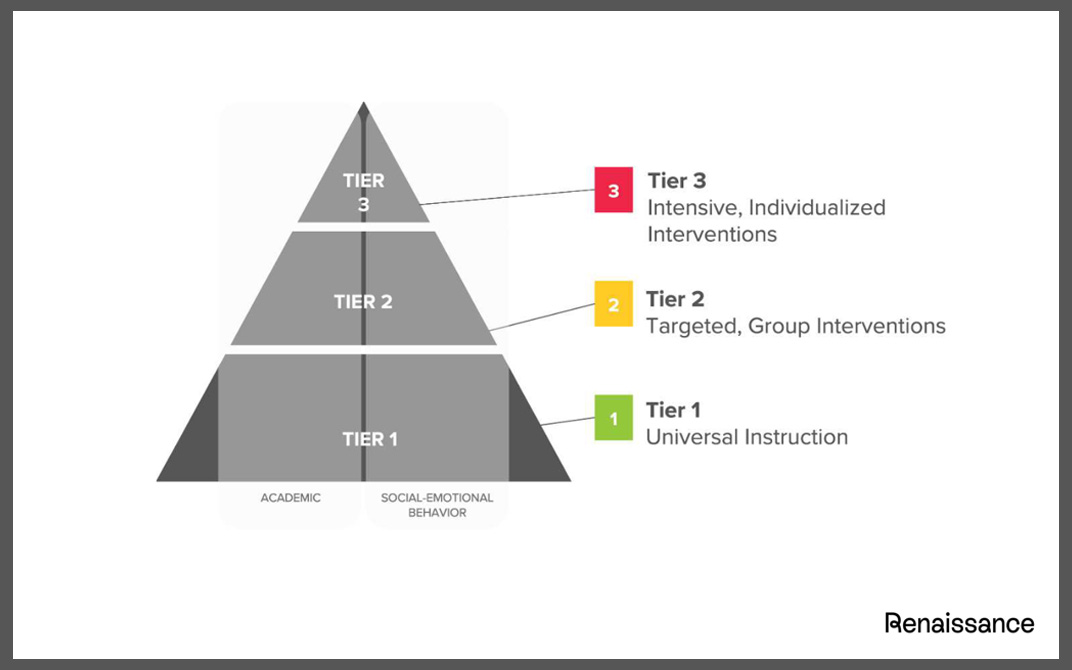January 18, 2023
One of the most difficult challenges students can face in the classroom is trying to achieve “catch-up growth,” which is defined as the amount of growth necessary to reach grade-level expectations. It’s also a challenge for educators to find the perfect balance of supplemental instruction and/or interventions to help students achieve catch-up growth. This is especially true now, in our new era of recovering from pandemic learning disruptions.
The good news is that there are effective tools educators can use when catch-up growth is needed. In this blog, I’ll explain what’s required and how Renaissance can help.
When do educators need to prioritize catch-up growth?
Consider this scenario: Molly is a fourth-grade student, but she reads at a first-grade level. Her teacher knows that her reading skills are much weaker than her classmates’ because the school conducts universal screening three times per year. Such screenings provide data that are used alongside other information about student performance to help teachers know which students need additional instruction.
In Molly’s case, the fall screening score on a broad reading measure like FastBridge aReading or Star Reading indicates that her current skills are like those of a typical first grader. This means that Molly is three grade levels behind her grade-level peers in reading. Efforts to improve Molly’s reading skills are clearly needed.
What role does MTSS play in educational catch-up growth?
If Molly’s school uses a multi-tiered system of support (MTSS) for reading, she is likely to participate in a daily reading intervention that includes daily specialized lessons. MTSS typically involves three levels of support:
- Tier 1 includes the general education curriculum and is provided for all students.
- Tier 2 usually includes about 30 minutes of targeted instruction and is in addition to the school’s Tier 1 core instruction.
- Tier 3 is provided to students who are significantly below grade level and can include either (a) additional instruction beyond Tier 1 and Tier 2, or (b) a replacement program that is used instead of the Tier 1 core.

In Molly’s case, the good news is that when such intervention is provided according to the methods validated through research, her reading skills are likely to improve.
Although providing intervention has been shown to improve the skills of students with significant reading problems, teachers often ask whether students like Molly can ever catch up and read like their typically achieving classmates. The honest answer is that for students to catch up, they’ll need to participate in a regular intensive intervention that focuses on gaining skills at a faster pace than their classmates. Without such intensive intervention, Molly is likely to experience the “Matthew Effect.”
Solutions for you
Discover assessment and practice solutions from Renaissance to support struggling readers.
The “Matthew Effect” in reading
For a student like Molly to catch up and meet grade-level reading expectations, she’ll need to improve her skills at a faster pace than her classmates. The reading researcher Keith Stanovich (1986) applied the term “Matthew Effect” to describe this phenomenon.
Stanovich’s research showed that students who learn to read in grades 1 and 2 go on to be strong readers, but those who struggle—without intervention—go on to be very poor readers. In other words, unless students with reading difficulties improve their reading skills at a faster rate than their classmates, they will never read at grade level.
Catch-up growth in education: How it works
It’s certainly possible for struggling students to catch up and to perform on grade level. However, for these students to reach grade-level expectations, effective and intensive intervention is required.
The term for the improvements needed by students who start out far behind is, accordingly, “catch-up growth.” This refers to the reality that when a student starts out behind other students, he or she will need to learn at a faster rate than classmates to catch up.
Catch-up growth is needed because most students improve their skills incrementally every year, which is known as annual growth. For students who start the school year performing on grade level, annual growth will be sufficient to reach that year’s learning goals. However, for students who start out below grade level, both annual growth and catch-up growth are needed in order to catch up to grade level. Otherwise, the student will experience the Matthew Effect and become farther behind each school year.
So, if a student who starts out below expectations improves his or her skills at the same pace as typically achieving students, gains will be made, but the student will still be behind others because his or her starting point was significantly lower than other students’.
An excellent resource for learning more about catch-up growth is the book The 90% Reading Goal by Fielding, Kerr, and Rosier (1998). This book explains how a low-income school district improved the reading scores of all students over many years.

How can catch-up growth be achieved in the classroom?
For a student to make above-average gains, both scientifically-based core instruction and additional intervention are usually needed. As I mentioned earlier, core instruction refers to the teaching materials and practices used to teach all students each day. For students who start out behind, providing additional instruction, also known as intervention, is needed.
The best way for schools to provide additional instruction is to use an MTSS model, which is sometimes known as Response to Intervention (RTI). Both MTSS and RTI provide tools for:
- Anticipating students’ learning needs
- Creating daily schedules that have time blocks set aside for additional instruction
- Setting goals and monitoring students’ progress
Let’s explore how each component can help students to achieve catch-up growth.
We support MTSS
Learn how Renaissance supports more effective MTSS at every grade level.
Anticipate learning needs
For students who need to achieve catch-up growth, educators must first anticipate these needs. There will always be students who fall into this group, and instruction must be designed in a way that will allow these students to find success.
A big part of anticipating learning needs is identifying the students who need interventions as soon as possible through universal screening measures. Universal screening allows educators to see students’ starting scores and evaluate how much, if any, intervention is needed.
Set aside additional instruction time blocks
Having scheduled times for additional instruction is essential for students who start out below grade level. As I noted earlier, the core instruction provided for all students is designed so that they make one year’s growth during one school year. This is perfect for students who start the year performing on grade level, but it does not meet the needs of those who are below grade level. To support these students, additional instruction that focuses on catch-up growth is necessary.
To provide additional instruction time to help students catch up, each school team needs to review its daily schedule and include a time block when all students can participate in intervention lessons. Importantly, daily intervention time blocks can be used to support all students by, for example, providing both remedial and extension lessons. Students who are behind use this time to catch up, while those who are already at grade level can use the time to accelerate their learning.
Set goals for achieving catch-up growth
Typically, students who enter into progress monitoring do so because they have been assigned an intervention or supplemental instruction to catch up to what’s expected at their grade level. It is crucial to consider the importance of goal setting when it comes to progress monitoring. Any given progress monitoring measure is only going to be useful in relation to a goal that has been set for a student.
Also, if we were to collect data without reference to a specific goal, there’s no way to know whether a student is making adequate improvements. For this to happen, we need to have guidance on how much growth is necessary for a student to catch up—and goals help to provide this guidance and serve as a bar from which to measure catch-up growth.
I suggest keeping two key points in mind when setting goals:
#1: Goals should be ambitious but realistic
The most important step in helping students to catch up is to use ambitious learning goals. Ambitious goals are those that result in a student making and sustaining learning gains that are bigger than other students’ gains.
While we want goals to be ambitious, they should also be attainable. If a goal is too easy, it won’t help a student to catch up. But over-ambitious goals may be impossible to attain and will set students up for frustration and failure.
#2: Goals should be based on research and created using effective tools
There is an extensive body of research on the importance of goal setting and how goal setting should be approached and implemented to be successful. Renaissance has used this research to create tools in FastBridge and Star Assessments to help educators calculate ambitious yet realistic goals for students who need to achieve catch-up growth.
These tools define goals based on several factors that are individualized for each student:
- Starting score: This is based on universal screening results and tells us where the student currently stands.
- Rate of Improvement (ROI): As with the end goal, the ROI should be above average but still attainable.
- End of school year timeline: We need to take into account how much time is left in the school year for the student to work toward the assigned goal.
Conclusion
Students who start a school year behind their classmates need to learn new skills faster than others in order to catch up to grade-level expectations. It is possible for students to achieve such catch-up growth, but only if schools:
- Anticipate these learning needs
- Organize daily schedules to provide additional instruction
- Set ambitious, research-based progress monitoring goals
When schools use models such as an MTSS and RTI, both general education/core instruction and supplemental intervention are provided. The combination of effective Tier 1 core instruction with Tier 2 and/or Tier 3 intervention creates a pathway for students who start out behind to catch up to peers.
Creating tiered supports requires an ongoing and coordinated effort by all teachers that affirms that, with the right resources and supports, students who start out behind can indeed reach grade-level expectations.
Discover the comprehensive assessment solution from Renaissance for universal screening, progress monitoring, goal setting, and more—for pre-K to grade 12 students.
References
Fielding, L., Kerr, N., & Rosier, P. (1998). The 90% reading goal. Kennewick, WA: The New Foundation Press.
Stanovich, K. (1986). Matthew effects in reading: Some consequences of individual differences in the acquisition of literacy. Reading Research Quarterly, 21, 360–407.

